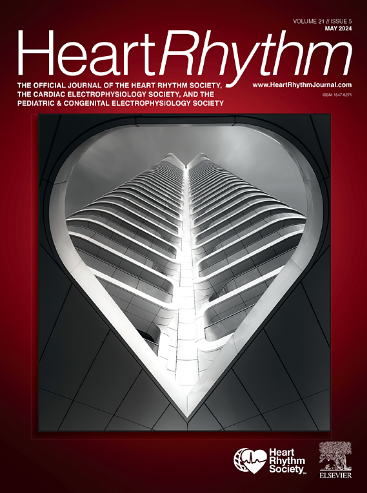Prospective randomized trial of conduction system pacing vs right ventricular pacing for patients with atrioventricular block; Prague CSP trial
IF 5.7
2区 医学
Q1 CARDIAC & CARDIOVASCULAR SYSTEMS
引用次数: 0
Abstract
Background
Conduction system pacing (CSP) replaces right ventricular pacing (RVP) in bradycardia patients.
Objective
To compare CSP vs RVP in patients with pacemaker indication due to atrioventricular conduction disease.
Methods
This study randomized patients to CSP or RVP in 1:1 ratio and followed them for 12 months. CSP received either His bundle pacing or left bundle branch area pacing; The primary end point was a change in the left ventricular ejection fraction (LVEF). The combined composite clinical end point consisted of cardiovascular death, cardiac resynchronization therapy upgrade, or hospitalization for heart failure.
Results
Of 249 patients, 125 were randomized to RVP and 124 to CSP; there were no differences between clinical parameters. In CSP, 10 patients received His bundle pacing, 96 left bundle branch area pacing, 15 deep septal pacing, and 3 RVP. Procedural and fluoroscopy times were longer in CSP vs RVP (63 vs 40 and 7 vs 3 minutes; P < .001). In the intention-to-treat analysis, the LVEF decline in CSP was smaller than RVP (−2% vs −4%, P = .03), and a LVEF decrease ≥ 10% occurred more often in RVP 19 (16%) than CSP 6 (5%), P = .01. There was no difference in the composite clinical outcome between RVP and CSP (9 vs 4, P = .15). There was also no difference in procedural complications (9 in RVP vs 2 in CSP, P = .09).
Conclusion
In patients with severe conduction disease, CSP led to a smaller LVEF decline than RVP after 1 year of pacing. Both pacing methods had similar rates of clinical end points and procedural complications.
传导系统起搏与右心室起搏治疗房室传导传导阻滞的前瞻性随机试验布拉格CSP试验。
背景:传导系统起搏(CSP)取代右心室起搏(RVP)治疗心动过缓患者。目的:比较心室传导疾病致起搏器指征患者的CSP与RVP。方法:将患者按1:1的比例随机分为CSP组和RVP组,随访12个月。CSP接受他束起搏(HBP)或左束支区起搏(LBBAP);主要终点是LVEF的变化。综合临床终点包括心血管死亡、CRT升级或因心力衰竭住院。结果:249例患者中,125例随机分为RVP组,124例随机分为CSP组;临床参数间无差异。在CSP中,10例患者接受HBP, 96例LBBAP, 15例深间隔起搏,3例RVP。CSP与RVP相比,手术和透视时间更长(63分钟vs 40分钟,7分钟vs 3分钟);P < 0.001)。在意向治疗分析中,CSP的LVEF下降幅度小于RVP (-2% vs -4%, p = 0.03), RVP 19(16%)比CSP 6(5%)更常出现LVEF下降≥10%,p = 0.01。RVP和CSP的综合临床结局无差异(9 vs. 4, p = 0.15)。手术并发症也无差异(RVP组9例,CSP组2例,p = 0.09)。结论:在严重传导疾病患者中,CSP在起搏1年后导致的LVEF下降幅度小于RVP。两种起搏方法的临床终点和手术并发症发生率相似。
本文章由计算机程序翻译,如有差异,请以英文原文为准。
求助全文
约1分钟内获得全文
求助全文
来源期刊

Heart rhythm
医学-心血管系统
CiteScore
10.50
自引率
5.50%
发文量
1465
审稿时长
24 days
期刊介绍:
HeartRhythm, the official Journal of the Heart Rhythm Society and the Cardiac Electrophysiology Society, is a unique journal for fundamental discovery and clinical applicability.
HeartRhythm integrates the entire cardiac electrophysiology (EP) community from basic and clinical academic researchers, private practitioners, engineers, allied professionals, industry, and trainees, all of whom are vital and interdependent members of our EP community.
The Heart Rhythm Society is the international leader in science, education, and advocacy for cardiac arrhythmia professionals and patients, and the primary information resource on heart rhythm disorders. Its mission is to improve the care of patients by promoting research, education, and optimal health care policies and standards.
 求助内容:
求助内容: 应助结果提醒方式:
应助结果提醒方式:


